Understanding Chronic Venous Insufficiency: Implications and Awareness

Summary
Full Article
Chronic Venous Insufficiency (CVI), a condition recently spotlighted by the diagnosis of President Donald J. Trump, is a prevalent yet often underrecognized health issue with significant implications for cardiovascular health. The American Heart Association emphasizes the importance of awareness and early treatment to mitigate the risks associated with CVI, including cardiovascular disease and increased mortality.
CVI affects the veins' ability to return blood from the legs back to the heart, leading to symptoms such as swelling, varicose veins, skin changes, and in severe cases, ulcerations. Risk factors include age, obesity, smoking, and a sedentary lifestyle, with advanced age being a significant contributor. The condition's impact on quality of life and its association with cardiovascular risks underscore the need for timely medical evaluation and intervention.
Diagnosis of CVI involves imaging techniques like duplex ultrasound, magnetic resonance venography, or computed tomography venography to identify vein obstructions or abnormal blood flow. Treatment options range from compression therapy and medications to minimally invasive procedures aimed at improving venous function.
The American Heart Association's 2025 Heart Disease and Stroke Statistics reveal the widespread impact of CVI, with thousands of hospital discharges and deaths attributed to the condition annually. These statistics highlight the critical need for increased awareness and understanding of CVI among both the public and healthcare providers.
With the recent attention brought to CVI by President Trump's diagnosis, the American Heart Association aims to educate the public on the condition's symptoms, risks, and the importance of early detection. By fostering greater awareness, the Association hopes to improve outcomes for those affected by CVI and reduce its associated cardiovascular risks.

This story is based on an article that was registered on the blockchain. The original source content used for this article is located at NewMediaWire
Article Control ID: 108381